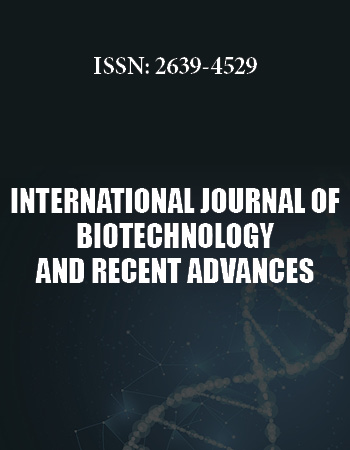Research Article
Effect of replacing different level of Crude Protein with Synthetic Amino acids on Growth Performance, Carcass Traits and Nutrient Digestibility in Broilers
1Institute of Animal Sciences, University of Agriculture, Faisalabad, 38040, Pakistan
2Evonik (SEA) Pte. Ltd., 609927, Singapore
3Department of Animal Nutrition, University of Veterinary and Animal Sciences Lahore, Pakistan
*Corresponding author: Muhammad Zain Ul Abiden, Institute of Animal Sciences, University of Agriculture, Faisalabad, Pakistan, E-mail: zainulabiden230@yahoo.com
Received: August 28, 2019 Accepted: September 23, 2019 Published: September 30, 2019
Citation: Ul Abiden MZ, Ali M, Yaqoob MU, Jamal A, Subhani A, Irfan A. Effect of replacing different level of Crude Protein with Synthetic Amino acids on Growth Performance, Carcass Traits and Nutrient Digestibility in Broilers. Int J Biotechnol Recent Adv. 2019; 2(1): 64-67. doi: 10.18689/ijbr-1000111
Copyright: © 2019 The Author(s). This work is licensed under a Creative Commons Attribution 4.0 International License, which permits unrestricted use, distribution, and reproduction in any medium, provided the original work is properly cited.
Abstract
Present study was conducted with the aim of replacing dietary crude protein (CP) in poultry diet with synthetic essential amino acids and to determine its effect on growth performance, slaughter data and nutrient digestibility in broilers. Five (A, B, C, D and E) iso-caloric & iso-nitrogenous (ME 2850/2950 Kcal/kg; CP 20%/18%) starter and finisher diets were formulated respectively. In both phase diet A was standard diet, in remaining starter/finisher diets (B, C, D and E) CP level was reduced (19/17, 18/16, 17/15 and 16/14) and make them iso-nitrogenous by supplementation of synthetic amino acids. Result showed no significant (P>0.05) effect of replacing CP with synthetic amino acids on all parameters of growth performance of broilers except on feed intake during starter phase. Best FCR during starter (1.33) and finisher (1.67) phase was found in broilers fed on diet B. Similarly, highest (P>0.05) dressing percentage with lowest (P>0.05) abdominal fat was observed in birds fed on diet B while highest (P>0.05) breast meat yield was found in control group. No significant (P>0.05) effect of replacing CP with amino acids was found on nutrient digestibility in both phase, highest digestibility was found in group C (75.50%) and E (79.84%) during starter and finisher phase, respectively. It is concluded that CP of boiler diet can be replaced by synthetic amino acids up to 17 and 15% in start and finisher diet, respectively without compromising the growth performance of broilers.
Keywords: Lysine; Methionine; Threonine; Growth performance; Slaughter data; Nutrient digestibility and Broilers.
Introduction
Protein is essential constituent of broilerʼs diet like carbohydrates, fats, vitamins and minerals. During the process of digestion proteins are converted into amino acids and absorb in small intestine and perform different structural and physiological functions [1]. Protein is the major and most costly component in poultry ration [2]. It is much difficult to meet the crude protein (CP) requirement in poultry ration compared with other essentials nutrient [3]. In modern poultry production system high weight gain with low FCR is require which mainly depends upon the provision of dietary protein, so dietary protein level is a major factor which controls weight gain, carcass characteristics [2]. The cost of protein feedstuffs are increasing consistently, thus increasing the feeding cost of broilers. Reducing protein and amino acid level of feed can reduce diet cost but it will result in poor performance [4].
Synthetic amino acids like lysine and methionine are supplemented in low protein diets to optimize the performance of broilers [5,6]. In broilerʼs diet methionine is one of the most limiting amino acids. Methionine is required for the growth performance i.e. maximum body weight gain of birds. For maximum mass production, amino acids i.e. L-lysine and DL-methionine are commonly replaced with natural protein [5]. During formulating a poultry diet, CP level in mainly emphasised because the protein level in the broilerʼs diet significantly affects performance, feed cost, and profitability of a broiler production enterprise [2,7]. Maximum growth performance and carcass quality of birds depend upon the proportion of lysine among all essential amino acids [5]. Synthetic amino acids especially lysine has positive effect on breast meat yield in broilers [8]. Synthetic essential amino acids have protein sparing effect and used to balance low CP diet [9]. Synthetic amino acids can be used in low protein diet for better growth performance and to improve feed conversion ratio [10].
The objective of present study was to examine the effect of replacing different levels of CP with synthetic amino acids on growth performance, slaughter data and nutrient digestibility in broiler.
Materials and Methods
Birds and experimental diets
Three hundred day-old boiler chicks (as hatched) of Hubbard strain were distributed in to five experimental groups with six replicate (10 chicks/replicate) in each group, under completely randomized design. Chicks were put in to floor pens. Fresh and clean water and feed was available ad libitum around the clock to them. There was two phases of experiment i.e. starter (1-21 days) and finisher (22-35 days) phase. Ten experimental diets, five for starter phase (Table 1) and five for finisher phase (Table 2) were formulated. During both phases diet A was served as control. Chemical composition of starter and finisher diets is given in tables 1 and 2, respectively.
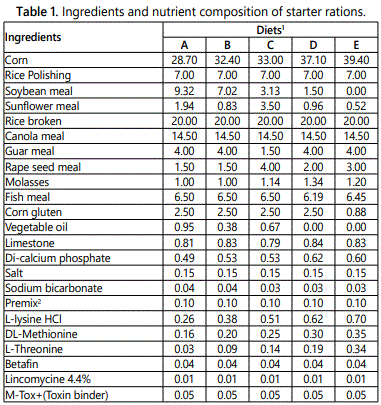
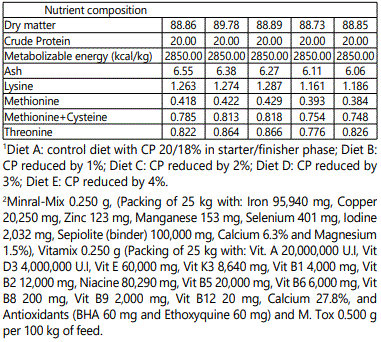
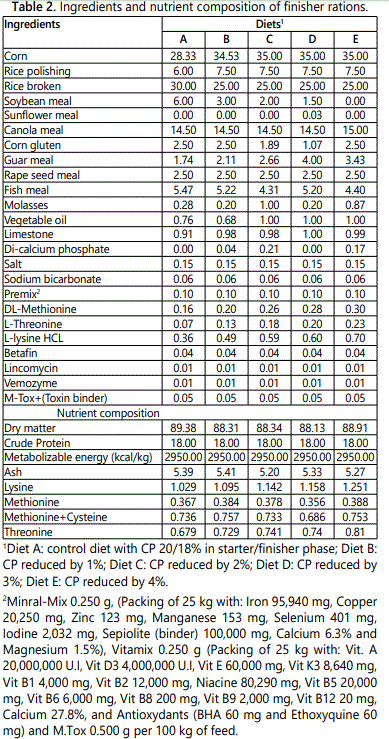
Procedure
Growth performance was studied on the bases of weight gain, feed consumption and feed conversion ratio (FCR). Daily feed intake and fort night weight gain was recorded to find FCR. The body weight of chicks was recorded on arrival at farm and at the end of every week, from each replicate. Data on feed intake of each replicate was recorded separately. Its value was calculated by subtracting the amount of feed refused from the total quantity of feed offered during the week. Feed conversion ratio is used to measure the birdʼs efficiency in converting feed weight into increased body weight. FCR was also corrected for dead birds. Data on mortality was recorded from each replicate throughout the experiment. Mortality was observed two times in 24 hours and weight of dead bird (if any) was also recorded.
Carcass characteristics
At the end of the trial, two birds from each treatment were selected on random basis. Weighed individually and slaughtered to obtain data on carcass characteristics. In order to get data on carcass characteristics, live body weight of birds was recorded. After slaughtering, the feathers were removed followed by evisceration in order to get dressed weight, breast meat weight, thigh meat weight and giblet organs weight (heart weight, liver weight and abdominal fat). Dressing percentage was calculated by dividing carcass weight including internal organs (heart, liver and gizzard) of the birds slaughtered.
Crude protein digestibility trial
Indirect marker method was used for determining nutrient digestibility. For this purpose, acid insoluble ash (Celite®) was added in the experimental diet @ 1%. Faeces samples were collected on day 20th and 33rd of trial. The polythene sheets were placed under each pen and droppings were collected twice a day. Faeces samples were stored at -10°C. Nutrient digestibility was determined by following relationship:
Chemical analysis
Proximate analysis of feed samples was done to find average value of dry matter (DM), crude protein (CP), ash percentage and crude fibre (CF). Feed samples were oven dried at 105°C for 4 h to find DM content. CP was calculated as N × 6.25 and nitrogen (N) was determined by Kjeldhal method [11].
Statistical analysis
Data collected for each parameter was analysed using PROC GLM procedure of Statistical Analysis System [12] under completely randomized design. The means were compared using Tukeyʼs test and the differences were checked for statistical significance (P<0.05).
Results
Growth performance
No significant (P>0.05) effect of dietary treatments was found on all parameters of growth performance, except on feed intake during starter phase. Highest weight gain was found in group D (789 g) and B (1114 g) during starter and finisher phase, respectively. Best FCR was observed in broilers fed diet B throughout experiment with 1.33 during starter phase and 1.67 during finisher phase (Table 3).
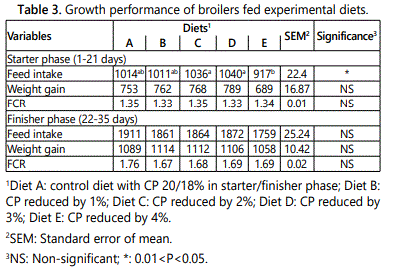
Slaughter data
Data of carcass characteristics showed no significant (P>0.05) effect of replacing crude protein with amino acids on all treatments except thigh and heart weight (Table 4). Highest dressing percentage (59.73%) with lowest abdominal fat pad (1.72%) was found in birds fed diet B. Highest breast meat yield (18.72%) was found in control group while best thigh (4.96%), heart (0.70%) and liver weight (2.86%) was found in broilers fed on diet E.
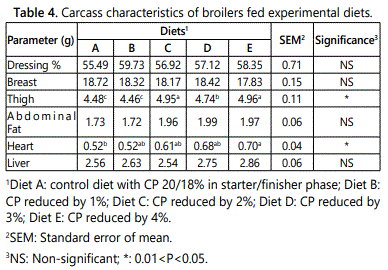
Crude protein digestibility
Crude protein digestibility was not affected (P>0.05) by feeding experimental diets to broilers during both phase (Table 5). Highest crude protein digestibility (%) was found in group C (75.50) and E (79.84) during starter and finisher phase, respectively.
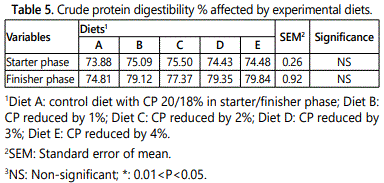
Discussion
Replacement of crude protein with synthetic amino acids is not only important for economical but also for nutritional and environmental aspects. Synthetic amino acids can be used in low protein diet for the maximum weight gain with best FCR [10]. Maximum growth performances with better carcass quality of birds depend upon the proportion of lysine among all essential amino acids [5]. Synthetic amino acids, especially lysine has main effect on breast meat yield in broilers [8].
The present study was conducted to find the level of crude protein which could be replaced safely with syntactic amino acids without compromising growth performance of broilers. Growth performance was studied on the bases of feed intake, weight gain and FCR. In present study growth performance was not affected significantly (P>0.05) by dietary treatments and a number of researchers have obtained similar results [9,13-15]. The results of the present trial on feed intake are in accordance with the results of [9,16,17] they found no difference in feed intake of broilers when dietary CP contents were decreased. FCR was slightly improved by decreasing dietary CP level, similar results were found in previous studies [9,16,17].
Results of present study showed that the dressing percentage, breast meat, liver weight, abdominal fat and liver weight were not affected (P>0.05) by feeding low CP content diet. No differences in the breast meat yield of the broiler chicks when the CP level was reduced and formulated to satisfy the essential amino acids needs [18,19]. The replacement of the dietary CP with amino acids supplementation had no effect on breast meat and liver weight yield of broilers [15,20]. Significant difference was observed in heart weight and thigh weight (P<0.05). Overall, the results of the present trial indicated that decreasing dietary CP level associated with optimal essential amino acids did not significantly affect the carcass characteristics. The results corresponded with those of Han et al. [9].
In the present experiment CP digestibility was not affected (P>0.05) by feeding experimental diets to broilers during both phase. Highest crude protein digestibility (%) was found in group C (75.50) and E (79.84) during starter and finisher phase, respectively.
Conclusion
This study concluded that crude protein level of broiler diet can be reduced to 17% in starter phase and 15% in finisher phase with supplementation of synthetic amino acids. Replacement of CP with synthetic amino acids up to above mentioned levels shows positive effect on growth performance, slaughter data and crude protein digestibility.
Acknowledgement
The authors acknowledge the financial support by EVONIK. The authors are also thankful for technical assistance and laboratory staff of Institute of Animal Science for performing the chemical analysis.
References
- Pond WG, Church DC, Pond KR. Basic Animal Nutrition and Feeding. 4th Edition. Canada. John Wiley and Sons, Inc. 1995.
- Firman JD, Boling SD. Ideal protein in turkeys. Poult Sci. 1998; 77(1): 105-110. doi: 10.1093/ps/77.1.105
- Ojano-Dirain CP, Waldroup PW. Protein and amino acid needs of broilers in warm weather: A review. Int J Poult Sci. 2002; 1(4): 123-129.
- Si J, Fritts CA, Burnham DJ, Waldroup PW. Relationship of dietary lysine level to the concentration of all essential amino acids in broiler diets. Poult Sci. 2001; 80(10): 1472-1479. doi: 10.1093/ps/80.10.1472
- Corzo A, Moran ET, Hoohler D. Lysine need of heavy broiler males applying the ideal protein concept. Poult Sci. 2002; 81(12): 1863-1868. doi: 10.1093/ps/81.12.1863
- Ahmad G, Mushtaq T, Mirza MA, Ahmad Z. Comparative bio efficacy of lysine from L-lysine hydrochloride or L-lysine sulfate in basal diets containing graded levels of canola meal for female broiler chickens. Poult Sci. 2007; 86(3): 525-530. doi: 10.1093/ps/86.3.525
- Sibbald IR, Wolynetz MS. Effect of dietary lysine and feed intake on energy utilization and tissue synthesis by broiler chicks. Poult Sci. 1986; 65(1): 98-105. doi: 10.3382/ps.0650098
- Han Y, Suzuki V, Parsons CM, Baker DH. Amino acid fortification of a low protein corn and soybean meal diet for chicks. Poult Sci. 1992; 71(7): 1168-1178. doi: 10.3382/ps.0711168
- Labadan MC, Hsu KN, Austic RE. Lysine and arginine requirements of broiler chicken at two to three week intervals to eight weeks of age. Poult Sci. 2001; 80(5): 599-606. doi: 10.1093/ps/80.5.599
- AOAC. Official Methods of Analysis of AOAC International. 17th edition. Gaithersburg, MD. USA. 2000.
- Dean DW, Bidner TD, Southern LL. Glycine supplementation to low protein, amino acid-supplemented diets supports optimal performance of broiler chicks. Poult Sci. 2006; 85(2): 288-296. doi: 10.1093/ps/85.2.288
- Waldroup PW, Kersey JH, Fritts CA. Influence of branched-chain amino acids balance in broiler diets. Int J Poultry Sci. 2002; 1(5): 136-144. doi: 10.3923/ijps.2002.136.144
- Kerr BJ, Kidd MT. Amino acid supplementation of low-protein broiler diets: 2. Formulation on an ideal amino acid basis. J Appl Poult Res. 1999; 8(3): 310-320. doi: 10.1093/japr/8.3.310
- Bartov I, Plavnik I. Moderate excess of dietary protein increases breast meat yield of broiler chicks. Poult Sci. 1998; 77(5): 680-688. doi: 10.1093/ps/77.5.680
- Hai DT, Blaha J. Effect of low protein diets with supplementation of essential amino acids on broiler chicken performance. AgricultureTropica-et-Subtropica. 1998; 31: 109-116.
- Rezaei M, Moghaddam HN, Reza JP, Kermanshahi H. The effects of dietary protein and lysine levels on broiler performance, carcass characteristics and N excretion. Int J Poult Sci. 2004; 3(2): 148-152. doi: 10.3923/ijps.2004.148.152
- Sterling KG, Pesti GM, Bakalli RI. Performance of different broiler genotypes fed diets with varying levels of dietary crude protein and lysine. Poult Sci. 2006; 85(6): 1045-1054. doi: 10.1093/ps/85.6.1045
- Kerr BJ, Kidd MT. Amino acid supplementation of low-protein broiler diets: 1. Glutamic acid and indispensable amino acid supplementation. J Appl Poult Res. 1999; 8(3): 298-309. doi: 10.1093/japr/8.3.298

